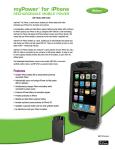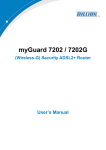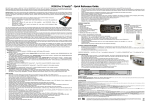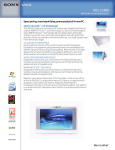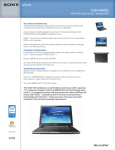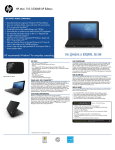Download Billion myGuard 7500GL User`s manual
Transcript
myGuard 7500GL 802.11g Security ADSL Router Quick Start Guide myGuard 802.11g Security ADSL Router Introduction In light of emerging threats of Viruses and growing demands for URL filtering from home users, Billion designs myGuardTM 802.11g Security ADSL Router, with central control and central guarding, to help identify vulnerabilities and protect PCs and networks while constant connected to the Internet. Billion’s myGuard integrates Security Service powered by Trend Micro includes Anti-Virus, Anti-Spam, Security Scan and Dynamic Parental Control Service (60-day trial free), in addition to security features of VPN, Firewall and Wi-Fi Protected Access. Simply connect computer(s) to Billion’s myGuard Security ADSL Router and launch broadband access, Billion’s myGuard Security ADSL Router will guard users’ home network and their PC. Security Services also address parents’ concerns of children going to inappropriate websites. In the meantime, users still enjoy the freedom of using Wireless WLAN technology. Package Contents myGuard 802.11g Security ADSL Router CD with the user’s manual in PDF format, router’s application, and Trend Micro Internet Security software. (For downloading Trend Micro Internet Security software, please read details on page 11)* RJ-11 ADSL/telephone Cable Ethernet (CAT-5 LAN) Cable Console (PS2-RS232) Cable AC-DC power adapter (12V DC, 1A) External Antenna This Quick Start Guide Do not use this router in high humidity or high temperature. Do not use the same power source for this router as other equipment. Warning Do not open or repair the case yourself. If this router is too hot, turn off the power immediately and have it repaired at a qualified service center. Avoid using this product and all accessories outdoors. Place this router on a stable surface. Attention Only use the power adapter that comes with the package. Using a different voltage rating power adaptor may damage the router. 1 Quick Start Guide The Front LEDs LED 2 Meaning 1 PWR Lit when power is ON. 2 SYS Lit when the system is ready. 3 LAN port 1 Lit when connected to an Ethernet device. Green for 100Mbps; Orange for 10Mbps Blinking when data is transmitted/received. 4 LAN port 2 Lit when connected to an Ethernet device. Green for 100Mbps; Orange for 10Mbps Blinking when data is transmitted/received. 5 LAN port 3 Lit when connected to an Ethernet device. Green for 100Mbps; Orange for 10Mbps Blinking when data is transmitted/received. 6 LAN port 4 Lit when connected to an Ethernet device. Green for 100Mbps; Orange for 10Mbps Blinking when data is transmitted/received. 7 WLAN Lit green when the wireless connection is established. Flashes when sending/receiving data. 10 MAIL Flash when there is Email in your configured Email account. 11 PPP Lit when there is a PPPoA / PPPoE connection. 13 ADSL Lit when successfully connected to an ADSL DSLAM (“linesync”). myGuard 802.11g Security ADSL Router The Rear Ports 2 3 4 5 6 1 Port 1 Meaning LINE Connect the supplied RJ-11 (“telephone”) cable to this port when connecting to the ADSL/telephone network. CONSOLE Connect a PS2/RS-232 cable to this port when connecting to a PC’s RS-232 port (9-pin serial port). 2 3 LAN 1X Connect a UTP Ethernet cable (Cat-5 or Cat-5e) to one of the 4X four LAN ports when connecting to a PC or an office/home (RJ-45 connector) network of 10Mbps or 100Mbps. — 4 RESET After the device is powered on, press it to reset the device or restore to factory default settings. 0-3 seconds: reset the device 6 seconds above: restore to factory default settings (this is used when you cannot login to the router. E.g. forgot the password) 5 PWR Connect the supplied power adapter to this jack. 6 Power Switch Power ON/OFF switch 3 Quick Start Guide Connecting Your ADSL Router 1. Connect the Router to a LAN (Local Area Network) and the ADSL/telephone (LINE) network. 2. Power on the device. 3. Make sure the PWR, SYS and WLAN LEDs are lit steadily and that the relevant LAN LED is lit. 4 myGuard 802.11g Security ADSL Router Configuring PC in Windows XP 1. Go to Start / Control Panel (in Classic View). In the Control Panel, double-click on Network Connections. 2. Double-click Local Area Connection. 3. In the Local Area Connection Status window, click Properties. 4. Select Internet Protocol (TCP/IP) and click Properties. 5. Select the Obtain an IP address automatically and the Obtain DNS server address automatically radio buttons. 6. Click OK to finish the configuration. 5 Quick Start Guide Configuring PC in Windows 2000 1. Go to Start / Settings / Control Panel. In the Control Panel, double-click on Network and Dial-up Connections. 2. Double-click Local Area Connection. 3. In the Local Area Connection Status window click Properties. 4. Select Internet Protocol (TCP/IP) and click Properties. 5. Select the Obtain an IP address automatically and the Obtain DNS server address automatically radio buttons. 6. Click OK to finish the configuration. 6 myGuard 802.11g Security ADSL Router Configuring PC in Windows 98/Me 1. Go to Start / Settings / Control Panel. In the Control Panel, double-click on Network and choose the Configuration tab. 2. Select TCP/IP -> NE2000 Compatible, or the name of your Network Interface Card (NIC) in your PC. 3. Select the Obtain an IP address automatically radio button. 4. Then select the DNS Configuration tab. 5. Select the Disable DNS radio button and click OK to finish the configuration. 7 Quick Start Guide Configuring PC in Windows NT4.0 1. Go to Start / Settings / Control Panel. In the Control Panel, double-click on Network and choose the Protocols tab. 2. Select TCP/IP Protocol and click Properties. 3. Select the Obtain an IP address from a DHCP server radio button and click OK. 8 myGuard 802.11g Security ADSL Router Configuring Your 802.11g Security ADSL Router To configure this device, you must have IE 5.5 / Netscape 4.5 or above installed Verifying Your Local Network Connection with the Device To see if this ADSL Router is visible on the local network, go to Start / Run. In the Run dialog box, type “ping 192.168.1.254” then press OK. A command prompt window will pop out. If your ping is successful which means your local network is able to reach to the device, then the command prompt window will close up automatically. Connection fails, when you see “Request timed out” in the command prompt window. You may need to check your set up. 9 Quick Start Guide Connecting to the Router Open the web browser and type http://192.168.1.254 in the browser’s address box. This number is the default IP address for this router. Press Enter. A user name and password window will appear. The default User Name and Password are “admin” and” admin”. Press OK to logon to the router 10 myGuard 802.11g Security ADSL Router Activating Trend Micro Security Services Before you can take full advantage of Trend Micro Security Services, you need to activate them. Available Services Security Scan Before Activation After Activation 60-day evaluation version Unlimited use. Not available. 60-day evaluation version with option to purchase for one-year use. Vulnerability reports Virus Scan Personal Firewall Spyware Protection Parental Controls To activate Trend Micro Security Services, perform the following: Step 1: Registering your Trend Micro account Step 2: Validating the Registration Email. You will be receiving the Serial number of your 60day trial Trend Micro Internet Security. Step 3: Installing Trend Micro Internet Security (named TIS 11.35 Package). *Important: you may download it through the Internet or CD folder named Trend Micro Internet Security Software. Please refer to TMSS Quick Start Card for a quick set up and check Trend Micro Internet Security user’s manual for more detailed information. Product Support and Contact Information Most problems can be solved by referring to the Troubleshooting section in the User’s Manual. If you cannot resolve the problem with the Troubleshooting chapter, please contact the dealer where you purchased this product. Contact Billion http://www.billion.com/ Mac OS is a registered Trademark of Apple Computer, Inc. Windows 98, Windows NT, Windows 2000, Windows Me and Windows XP are registered Trademarks of Microsoft Corporation. 11













